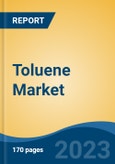Speak directly to the analyst to clarify any post sales queries you may have.
10% Free customizationThis report comes with 10% free customization, enabling you to add data that meets your specific business needs.
These derivatives are extensively used in sectors such as automotive, construction, consumer goods, and electronics. The compound’s role in fuel blending, particularly in boosting octane ratings, further underscores its importance in energy applications. Toluene is widely adopted in industries including petrochemicals, paints and coatings, adhesives, and pharmaceuticals due to its versatility. As infrastructure projects and industrialization accelerate - particularly in Asia-Pacific and other developing regions - demand for toluene is expected to grow steadily across its diverse application segments.
Key Market Drivers
Rising Demand for Chemical Intermediates
The increasing consumption of chemical intermediates such as benzene, xylene, and toluene diisocyanate (TDI) is significantly fueling the demand for toluene. These intermediates are essential inputs in the manufacture of polyurethanes, dyes, adhesives, synthetic fibers, plastics, and resins - materials integral to automotive, packaging, construction, textiles, and electronics industries. The construction and automotive sectors, in particular, rely heavily on polyurethane foams and lightweight plastics, both of which are derived from toluene-based intermediates. Rapid industrial growth and urban infrastructure expansion, especially in Asia-Pacific, Latin America, and the Middle East, are contributing to an upsurge in demand. As global manufacturing capacity expands to meet rising consumer needs, the role of toluene as a base chemical continues to gain strategic significance across industrial value chains.Key Market Challenges
Health and Safety Concerns
The global toluene market faces mounting pressure due to health and safety risks associated with its usage. Toluene exposure, particularly in industrial environments, can result in adverse health effects including neurological impairment, respiratory irritation, and long-term toxicity. In light of these risks, governments and regulatory bodies are enforcing tighter restrictions to mitigate occupational and environmental hazards. For instance, in December 2023, India’s Bureau of Indian Standards (BIS) issued the Toluene (Quality Control) Second Amendment Order, banning the use of toluene-based inks in food packaging from December 2024. This regulation reflects broader efforts to limit human exposure to potentially harmful chemicals in everyday products. Increasing regulatory oversight poses operational challenges for manufacturers, compelling them to adopt safer production practices or explore alternative solvents - thereby impacting the traditional usage landscape of toluene.Key Market Trends
Growing Demand of Toluene in Paints and Coatings Industry
Toluene is gaining prominence in the paints and coatings industry due to its strong solvency capabilities, which enable effective dispersion of resins, pigments, and additives. It helps achieve optimal viscosity and application consistency, contributing to faster drying times and enhanced finish quality. As global construction and infrastructure development accelerates - particularly in urban areas - the demand for decorative and industrial coatings has risen sharply, thereby boosting toluene consumption. Moreover, toluene’s low VOC content aligns with the industry's increasing preference for environmentally sustainable solvents. Its role is also expanding in high-performance coating segments like aerospace, marine, and energy, where it contributes to improved durability and resistance. These factors collectively position toluene as a preferred solvent across a broad spectrum of performance and industrial coatings.Key Market Players
- Shell Plc
- Exxon Mobil Corporation
- Valero Energy Corporation
- China Petrochemical Corporation (SINOPEC)
- Reliance Industries Limited
- China National Petroleum Corporation (CNPC)
- BP p.l.c
- Saudi Arabian Oil Company (Saudi Aramco)
- BASF SE
- Mitsui Chemicals, Inc.
Report Scope:
In this report, the Global Toluene Market has been segmented into the following categories, in addition to the industry trends which have also been detailed below:Toluene Market, By Derivative:
- Benzene & Xylene
- Solvents
- Gasoline Additives
- Toluene Diisocynate (TDI)
- Tri Nitro Toluene (TNT)
- Others
Toluene Market, By Application:
- Drugs
- Dyes
- Blending
- Cosmetic Nail Products
- Polymer Production
- Others
Toluene Market, By Region:
- North America
- United States
- Canada
- Mexico
- Europe
- France
- United Kingdom
- Italy
- Germany
- Spain
- Asia Pacific
- China
- India
- Japan
- Australia
- South Korea
- South America
- Brazil
- Argentina
- Colombia
- Middle East & Africa
- South Africa
- Saudi Arabia
- UAE
Competitive Landscape
Company Profiles: Detailed analysis of the major companies present in the Global Toluene Market.Available Customizations:
With the given market data, the publisher offers customizations according to a company's specific needs. The following customization options are available for the report.Company Information
- Detailed analysis and profiling of additional market players (up to five).
This product will be delivered within 1-3 business days.
Table of Contents
Companies Mentioned
- Shell Plc
- Exxon Mobil Corporation
- Valero Energy Corporation
- China Petrochemical Corporation (SINOPEC)
- Reliance Industries Limited
- China National Petroleum Corporation (CNPC)
- BP p.l.c
- Saudi Arabian Oil Company (Saudi Aramco)
- BASF SE
- Mitsui Chemicals, Inc.
Table Information
| Report Attribute | Details |
|---|---|
| No. of Pages | 188 |
| Published | June 2025 |
| Forecast Period | 2024 - 2030 |
| Estimated Market Value ( USD | $ 21.45 Billion |
| Forecasted Market Value ( USD | $ 28.19 Billion |
| Compound Annual Growth Rate | 4.8% |
| Regions Covered | Global |
| No. of Companies Mentioned | 10 |









